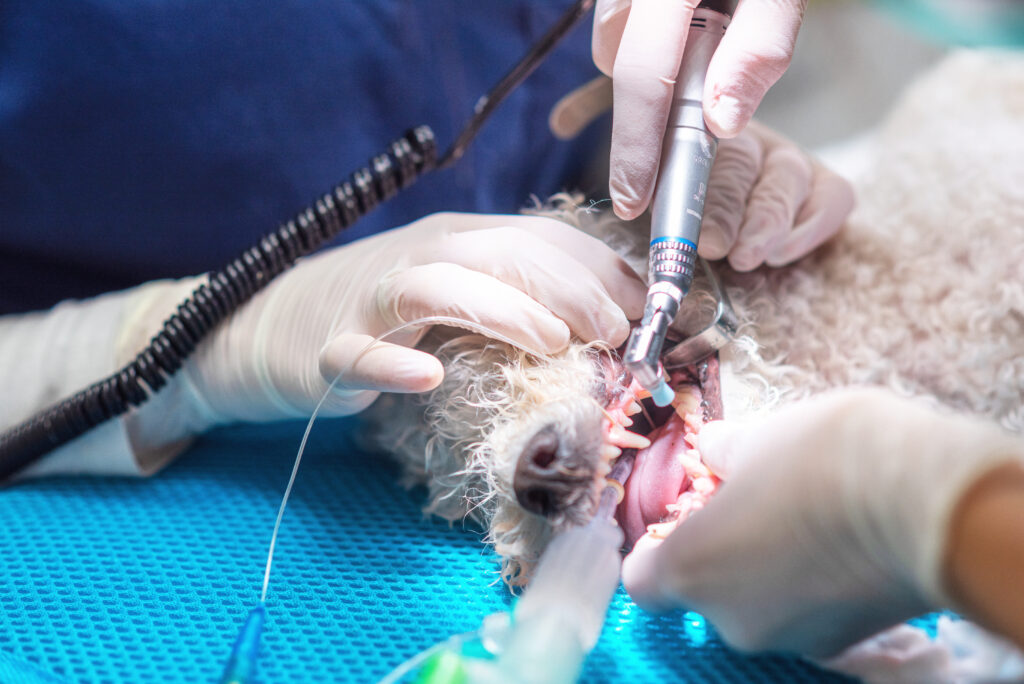
Dentistry is a rapidly growing area of veterinary science. We have seen a greater awareness over the last 25 years of its importance to the overall health of the animals we treat.
Just like humans, pets’ teeth need looking after too! The health of their teeth and gum’s has a significant impact on their overall quality of life. Imagine how your mouth would feel, and smell, if you never brushed your teeth. Imagine having a really bad toothache and not being able to tell anyone about it!
Dental disease begins with a build up of bacteria in your pet’s mouth. Bacteria, combined with saliva and food debris, can cause plaque to accumulate on the tooth. As calcium salts are deposited, plaque turns to tartar (brown or yellow material starting near the gum line of the tooth). Without proper preventive or therapeutic care, plaque and tartar build-up leads to periodontal disease, which affects the tissues and structures supporting the teeth. Periodontal disease can cause oral pain, tooth loss and even heart or kidney problems.
Common signs of dental disease, in order of severity, include:
If your pet is showing any of these signs of dental disease please book an appointment to see one of our veterinarians. Early assessment and action can save your pet’s teeth!
How Can I Prevent Dental Disease?
Long-term control and prevention of dental disease requires regular home care. The best way to begin this is to accustom your pet from an early age. Dental home care may include:
Regular and frequent attention to your pet’s teeth may avoid the need for a professional dental clean under anaesthetic, and will also improve your pet’s overall health.
What Does A Professional Dental Clean Involve?
It is much the same as what is done in the human world, however, unlike us, our pets won’t sit still to open their mouth to allow a comprehensive cleaning of their teeth. For this reason our pets need to have a general anaesthetic for a veterinarian to perform a complete mouth exam, dental radiographs, a scale and polish and assess the degree of dental disease to determine if extractions are necessary. These steps are performed in stages.
What Is A Staged Dental?
A ‘staged dental’ involves dividing the dental procedure into multiple stages. Similar to how human dentists work.
During stage 1, we will conduct a comprehensive oral examination while your pet is under anaesthesia. This includes full-mouth dental x-rays to assess the health of each tooth. It helps us determine which teeth require treatment or potential extraction. Stage 1 finished with an ultrasonic scale and polish. With this information, we will be able to formulate a treatment plan and provide an accurate estimation of the costs. Minor work like scale and polishing will be performed during stage 1. Extensive dental work, like extractions, will be scheduled for stage 2, on another day.
Why Are Dental X-rays So Important?
Unlike humans, our pets can’t tell us what hurts. Dental x-rays allow us to see the health of the teeth above and below the gumline up into the jaw bone. They are crucial for several reasons:
Overall, dental x-rays in veterinary care are indispensable for comprehensive dental evaluations and ensuring optimal oral health for pets.
So Now The X-rays Are Done, What’s Next?
After the dental x-rays are performed and a comprehensive mouth exam is completed, the vet will determine what treatment is recommended for your pet. Best case scenario; your pet requires a dental cleaning only, which will be performed on the same day during the same anaesthetic. We just ask you to continue dental hygiene practices at home.
A stage 2 visit will be necessary if the vet finds need for teeth to be extracted. We will be able to provide you with an accurate cost estimate for this. Stage 2 must be performed within 4 weeks of stage 1, to ensure no further changes can occur and our treatment plan remains suitable. We aim to address your pet’s dental disease within a timely manner.
And Why Can’t This Be Done In One Visit?
Anaesthetic safety.
Did you know it’s riskier for a pet to undergo one prolonged anaesthesia session compared to several shorter ones? This is because during anaesthesia, animals can experience physiological changes such as decreased body temperature, lowered blood pressure, and fluctuations in cardiac rhythm. By dividing the procedures into shorter sessions, bodily stress is reduced, ensuring the safety of your cherished pet.
Historically, veterinarians have conducted dental procedures in a single appointment, keeping pets under anaesthesia for extended periods and leaving owners uncertain about treatment and costs. We aim to provide comprehensive diagnostics and efficient treatment plans, which will result in better health for your pet and no surprises for our clients at discharge time.
